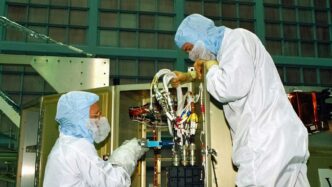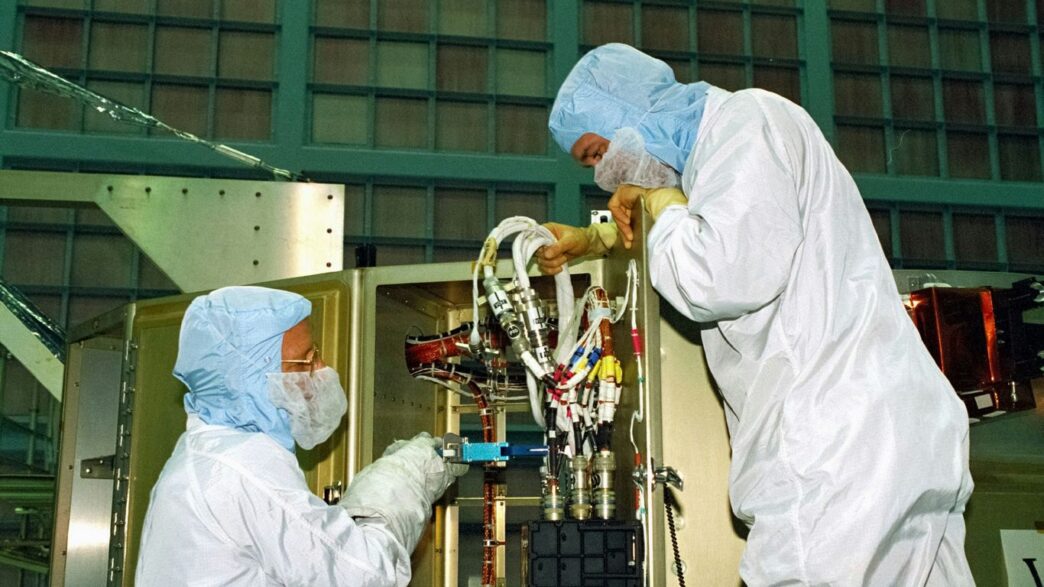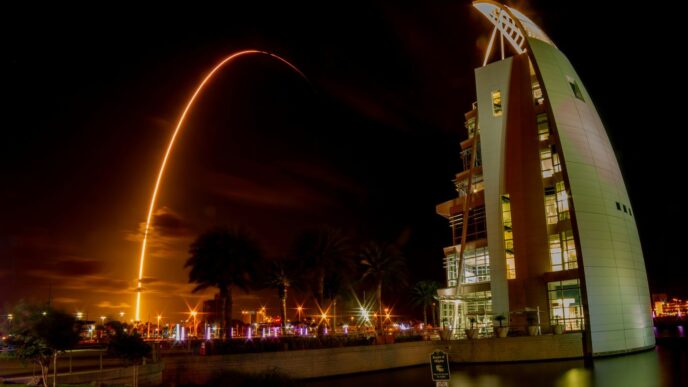You might have heard about the push for Europe to do more in space, right? Well, there’s this company, Aerospacelab, that’s really stepping up. They’re not just building satellites; they’re building them in a big, new way, kind of like a car factory. This means they can make a lot more, faster, and hopefully, cheaper. It’s all about making sure we can get a good look at Earth from space whenever we need it, and doing it with European technology. They’ve got some serious backing and some cool ideas for future missions.
Key Takeaways
- Aerospace Lab is building Europe’s largest satellite factory, aiming for a massive production capacity.
- They’re using an automotive-style assembly line approach to build satellites more efficiently.
- The company focuses on making Earth observation data affordable and easy to use for important decisions.
- Significant funding, including from the European Investment Bank, is fueling their expansion and autonomy goals.
- Aerospace Lab is developing its own satellite constellations and platforms to boost European independence in space.
Aerospace Lab’s Ambitious Manufacturing Expansion
Aerospacelab is really going big with its satellite production plans. They’re building what they call a "megafactory" in Charleroi, Belgium, and it’s set to be the largest of its kind in Europe. We’re talking about a place that could churn out up to 500 satellites a year. That’s a huge jump from their current facility in Ottignies-Louvain-La-Neuve, which can handle about 24 satellites annually.
The European Satellite Megafactory Initiative
This whole megafactory project is a pretty big deal for Europe. It’s all about ramping up production to meet the growing demand for satellites. They’ve got this idea of making satellites more accessible and affordable, and building a factory this size is a major step towards that goal. It’s not just about making more satellites, but making them in a way that’s efficient and scalable.
Vertical Integration for Enhanced Agility
What’s interesting is how Aerospacelab is doing things. They’re taking a "vertically integrated" approach. Basically, they’re handling a lot of the process in-house, from designing the satellites to testing the hardware. This means they have more control over the whole production chain. It helps them be more flexible and quicker to respond when things need to change or when they get a new idea. They own and operate all their testing facilities, which really gives them an edge.
Automotive-Inspired Production Lines
They’re actually looking at the automotive industry for inspiration. You know how car factories have assembly lines? Aerospacelab is setting up similar production lines for satellites. They plan to use a lot of standard, "off-the-shelf" components, but still allow for customization. This blend of standardized production with the ability to tailor satellites for specific needs is a smart way to speed things up without losing flexibility. It’s a pretty novel approach for satellite manufacturing, trying to get that mass-production efficiency while still building sophisticated spacecraft.
Transforming Geospatial Intelligence Accessibility
It’s pretty wild how much the world of Earth observation has changed, right? Aerospacelab is really shaking things up, making it way easier for everyone to get their hands on useful satellite data. They’re not just building satellites; they’re building a whole new way to think about how we use that information.
Actionable and Affordable Earth Observation
Gone are the days when getting high-quality satellite images felt like a luxury only big governments or huge corporations could afford. Aerospacelab is changing that. They’ve got this idea of making Earth observation data not just available, but actually useful and budget-friendly. Think about it: more people can now access detailed views of our planet, which is a big deal for all sorts of fields.
Supporting Critical Decision-Making
This isn’t just about pretty pictures of clouds. The data coming from these satellites can help people make really important choices. Farmers can get a better idea of crop health, city planners can monitor urban sprawl, and environmental agencies can track changes in forests or water bodies. The goal is to turn raw satellite data into clear, actionable insights that help guide decisions, big and small.
Enabling Same-Day Earth Surface Monitoring
One of the most exciting parts is the speed. Aerospacelab is working towards being able to provide updated information on the Earth’s surface almost in real-time. Imagine being able to see changes happening today, not weeks or months ago. This kind of rapid monitoring is a game-changer for disaster response, tracking fast-moving environmental events, or even keeping an eye on agricultural cycles as they unfold. It means we can react faster and more effectively to what’s happening on the ground.
State-Of-The-Art Aerospace Lab Facilities

Aerospace Lab isn’t just talking about building satellites; they’re putting their money where their mouth is with some seriously impressive facilities. They’ve got two main hubs that are really the engine behind their operations.
The Monnet Center Production Hub
First up is the Monnet Center, located in Ottignies-Louvain-la-Neuve. This place is already up and running and serves as their initial production site. It’s not massive, but it’s got everything they need to get started. Think of it as their proving ground where they fine-tuned their processes.
- Size: Around 2,000 square meters of total working space.
- Cleanroom: A dedicated 550 square meter cleanroom for sensitive assembly.
- Labs: An additional 420 square meters for various testing and development labs.
- Capacity: Capable of producing about 24 satellites per year.
This facility was key in getting their first satellites built and tested, laying the groundwork for what was to come.
The Charleroi Megafactory Under Construction
Now, this is where things get really big. The Charleroi Megafactory is their future flagship facility, and it’s designed for serious mass production. It’s being built with the idea of churning out satellites at a pace never really seen before in Europe.
- Location: Situated in Charleroi, Belgium.
- Scale: A massive 17,500 square meters of working space.
- Advanced Cleanroom: Features a huge 4,500 square meter cleanroom.
- Extensive Labs: Includes 2,000 square meters dedicated to advanced laboratories.
- Production Goal: Aiming for a yearly capacity of 500 satellites.
This factory is a game-changer, allowing them to meet the growing demand for satellite constellations efficiently. It’s set to become one of the most advanced satellite manufacturing plants in all of Europe.
Advanced Testing and Cleanroom Capabilities
Across both facilities, a major focus is on having top-notch testing and cleanroom environments. This isn’t just about having space; it’s about control. Cleanrooms are vital for satellite manufacturing because even tiny dust particles can cause major problems once a satellite is in orbit. Aerospace Lab has invested heavily in these controlled environments to make sure their satellites are built to last.
Their testing capabilities are also extensive. They handle everything from component testing to full system integration checks. Owning and operating these facilities themselves is part of their strategy for vertical integration. It means they have direct control over quality and can speed up development cycles without relying on outside vendors for critical testing steps. This hands-on approach is what gives them their agility.
Strategic Funding Fuels Aerospace Lab’s Growth
It’s pretty wild how much money is flowing into the space industry these days, and Aerospacelab is definitely riding that wave. They’ve managed to pull in some serious cash, which is a big deal for their plans to build more satellites and get them up there faster. This isn’t just pocket change; it’s the kind of investment that really changes the game.
Back in February 2022, they announced a Series B funding round that brought in a hefty €94 million. That’s about $110 million USD, for those keeping track. This money came from a couple of places. A good chunk, €56 million, was from private investors who clearly see the potential in what Aerospacelab is doing. Then, there was another €38 million from a European financial institution, which sounds like the European Investment Bank, a pretty significant backer for European tech companies. This kind of support is exactly what they need to push forward with their ambitious plans.
So, what are they doing with all this funding? Well, it’s pretty straightforward:
- Scaling Up Production: A big part of the cash is going into building out their "Megafactory" in Charleroi. This place is designed to churn out satellites at an impressive rate, aiming for up to 500 per year. Think of it like an automotive factory, but for satellites – standardized processes with room for customization.
- Vertical Integration: They’re also using the money to bring more of the manufacturing process in-house. This means they have more control over quality and can move faster when they need to make changes or develop new tech. It’s all about building their own capabilities rather than relying too much on outside suppliers.
- Accelerating the Roadmap: Ultimately, this funding is about speeding up their entire plan. They want to get more satellites built, launched, and operating, which helps them achieve their goal of providing more frequent and affordable Earth observation data. It’s about building out their own constellation and making sure they have the industrial muscle to back it up.
It’s clear that Aerospacelab has a solid plan, and this funding is the fuel they need to make it happen. It shows a lot of confidence from investors and financial institutions in their vision for the future of satellite manufacturing and Earth observation.
Pioneering European Autonomy in Space
Europe’s push for independence in space is a big deal, and Aerospacelab is right in the middle of it. Think about it: space is becoming a critical area for everything from national security to everyday communication. Having our own capabilities means we’re not relying on others for vital information or services. It’s about building our own infrastructure and know-how, right here on the continent. This isn’t just about launching rockets; it’s about developing the technology, the manufacturing, and the operational skills to be self-sufficient.
Bolstering Security and Intelligence Capabilities
When we talk about security and intelligence, space plays a huge role. Satellites can watch over large areas, gather information, and provide communication links that are hard to disrupt. Aerospacelab’s work on high-resolution imaging satellites is directly contributing to this. These aren’t just pretty pictures; they’re data that can help monitor borders, track movements, and respond to situations quickly. By developing these indigenous capabilities, Europe strengthens its ability to act independently and protect its interests. This is especially important in a world where geopolitical situations can change fast. Having our own eyes in the sky means we have more control over our own security.
Indigenous Constellation Development
Building a constellation of satellites is like creating a network of interconnected satellites that work together. Aerospacelab is focused on developing its own constellations, which is a major step towards European autonomy. Instead of using satellite services from other countries, Europe can rely on its own system. This means more control over data, better security, and the ability to tailor the constellation to specific European needs. It’s a complex undertaking, involving not just the satellites themselves but also the ground systems and the software to manage them. This homegrown approach is key to ensuring Europe has consistent and reliable access to space-based services.
Fusing New Space Practices with Industrial Know-How
What’s really interesting about Aerospacelab is how they combine the fast-paced, innovative methods of ‘New Space’ companies with the solid, established practices of traditional European industry. New Space often means being agile, quick to adapt, and using modern manufacturing techniques. Traditional industry brings decades of experience, quality control, and a deep understanding of complex engineering. By blending these two worlds, Aerospacelab is creating a unique model. They can build satellites faster and more affordably, like a startup, but with the reliability and quality that established players expect. This fusion is a blueprint for how Europe can stay competitive in the global space race, building on its strengths while embracing new ways of working. It’s a smart way to build capabilities that are both cutting-edge and dependable, supporting the broader European space ecosystem.
Here’s a look at how their production capacity is scaling up:
| Facility | Location | Cleanroom Size (sqm) | Lab Space (sqm) | Yearly Capacity | Est. Production Start |
|---|---|---|---|---|---|
| Monnet Factory | Ottignies-Louvain-la-Neuve | 550 | 420 | 24 satellites | Q3 2022 |
| Megafactory | Charleroi | 4,500 | 2,000 | 500 satellites | Q1 2025 |
Innovative Satellite Platforms and Missions
The Versatile VSP-150 Platform
Aerospacelab’s Versatile Satellite Platform, or VSP-150, is really the backbone of a lot of what they’re doing. It’s designed for missions in Low Earth Orbit and, honestly, its main selling point is how adaptable it is. Think of it like a really flexible chassis that can be fitted with all sorts of different equipment. Since its first successful launch back in 2023, it’s been used for a bunch of different things. We’ve seen it carrying payloads for Earth Observation, including high-resolution optical sensors for satellites like ROSE, multispectral imagers on the SPIP satellite, and even radio frequency sensing gear on the Castor Seniors trio. It’s pretty cool how one basic design can be tweaked for so many different jobs. This adaptability is key to their strategy of getting new applications into space quickly and reliably.
The NAHLA Satellite for Bio-Agricultural Monitoring
Then there’s NAHLA, which is a pretty neat example of a specialized mission built on their flexible platform. Developed with input from the Flemish Institute for Technological Research (VITO) and supported by the European Space Agency (ESA), NAHLA is all about keeping an eye on bio-agricultural areas. The main instrument on board, called CSIMBA, is a hyperspectral imager. It can capture data across 150 different spectral bands, giving a really detailed look at the land over an 80 km wide area. This level of detail helps in monitoring farming activities and environmental changes. It’s a collaboration that really shows what European partners can achieve when they work together on advanced tech.
Mission-as-a-Service Delivery Model
What’s also interesting is how Aerospacelab is changing the way they deliver their services. With missions like IPERLITE, they’re moving towards a "Mission-as-a-Service" model. Basically, Aerospacelab handles everything from building and launching the satellite to managing the ground systems. Their main job is to get the specific data that the user needs, like the imagery from VITO in the case of IPERLITE. This approach streamlines the whole process, letting them focus on producing high-quality results and making sure they hit certain performance targets. It’s a more focused way to get valuable data down to Earth without the user having to worry about the complex space stuff.
Looking Ahead
So, Aerospacelab is really changing the game when it comes to making satellites. They’re building these huge factories, like the one in Charleroi, which is going to be massive, able to churn out 500 satellites a year. It’s kind of like a car factory, but for space stuff, using parts that are easy to get. This whole approach means they can make satellites faster and maybe even cheaper, which is a big deal for getting more eyes on Earth from space. They’re not just building satellites, though; they’re also using them to gather information that can help with things like farming, protecting the environment, and keeping an eye on infrastructure. With all the money they’ve raised and these big plans, it looks like Aerospacelab is set to play a major role in Europe’s space future, making Earth observation more accessible for everyone.
Frequently Asked Questions
What is Aerospacelab building?
Aerospacelab is building big factories to make lots of satellites. Think of it like a car factory, but for satellites! Their new megafactory in Charleroi will be able to make 500 satellites a year, which is a huge amount. They also have a smaller factory already making 24 satellites annually.
Why are they making so many satellites?
They want to make it easier and cheaper for people and organizations to get information about Earth from space. This information, called Earth observation, can help us understand things like farming, weather, and protecting our environment. They aim to provide this useful data quickly and affordably.
What makes Aerospacelab special?
Aerospacelab does almost everything themselves, from designing the satellites to testing them. This is called vertical integration. It helps them be quicker and more flexible. They are also inspired by car manufacturing, using common parts to build specialized satellites efficiently.
How is Aerospacelab getting the money to grow?
They have received a lot of money from investors, including a big amount called Series B funding. They also have a partnership with a European financial group. This money helps them build their new factories and develop more satellites faster.
What is the NAHLA satellite for?
The NAHLA satellite is designed to help us learn more about farming and nature. It uses special cameras to see details about plants and the land. This helps scientists and farmers understand how crops are growing and how to take better care of our planet.
What does ‘Mission-as-a-Service’ mean?
It means Aerospacelab provides the whole package for a satellite mission. They build and operate the satellite, and then they deliver the information you need, like pictures of Earth. It’s like ordering a service instead of buying and managing all the complicated parts yourself.












